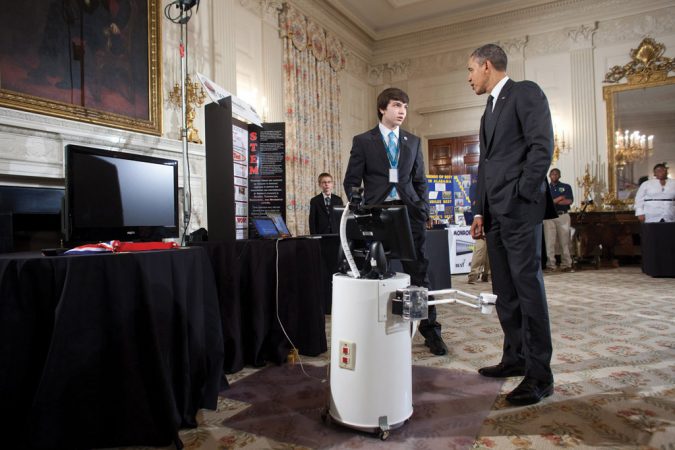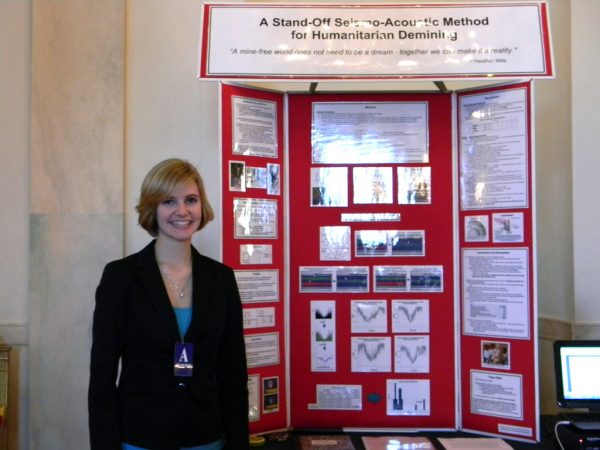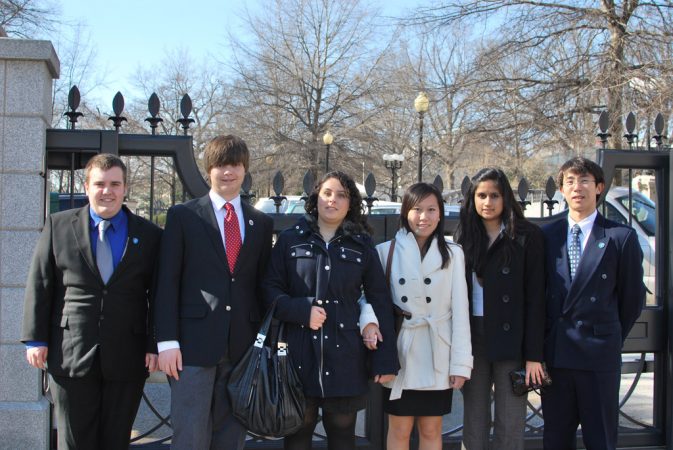The White House welcomes science
Students are honored at a special science fair at the president’s home

MAYA may just be the weirdest guest ever at the White House. And that’s saying a lot. The family of President Calvin Coolidge, who served from 1923 to 1929, kept exotic pets, including a raccoon named Rebecca and — very briefly — a black bear. But unlike MAYA, none of those pets was a robot made out of a recycled trash can and an old cordless vacuum cleaner.
On a February day, MAYA the robot stands next to its creator, 14-year-old Benjamin Hylak, in the White House’s State Dining Room. Reporters carrying TV cameras and political aides wearing suits zip in and out of the ornate gallery. Earlier, Hylak, a freshman at Salesianum High School in Wilmington, Del., talked about his invention with an eager President Obama. It’s all part of the second-ever White House Science Fair, an event held to honor young scientists and engineers.
Hylak’s creation is certainly worth the attention. He designed MAYA, short for Me And You Anywhere, for a simple but important purpose — to help people communicate. For MAYA’s head, Hylak attached a used netbook computer onto the robot’s shoulders. Using a camera attached to that computer, people can make video chat calls to any other computer connected to the Internet. Months before bringing MAYA to the White House, Hylak wheeled the robot to his grandmother’s nursing home. There, residents were able to speak with and see faraway loved ones, as if they were in the same room.
This story didn’t escape Obama’s attention. “Inventions like Benjamin’s could make life better for millions of families,” he said in a speech following the fair, which was held on February 7.
And Hylak wasn’t alone in turning science into a tool for helping people. He and nine other students that had competed in national science competitions sponsored by Society for Science & the Public — or SSP, the publisher of Science News for Kids — toured the White House this February. Their projects ranged from clever inventions, such as a new type of land-mine detector, to a study exploring the behavior of hurricanes.
“What impressed me so much is not just how smart you are but the fact that you recognize that you’ve got a responsibility to use your talents in service of something bigger than yourselves,” Obama said, addressing the visiting students.
Helping at home and abroad
More than 100 students were invited this year to the White House event, including 33 teams that exhibited their work. That’s more than double the number that displayed projects at the inaugural White House Science Fair, in October 2010.
Standing below a portrait of Abraham Lincoln after Obama’s speech, Hylak demonstrated to a small audience how MAYA works. First, the old computer monitor on its shoulders is blank. Then, Hylak, who’s a few feet away, appears on-screen grinning, as if the robot suddenly grew a human face. The video, he explains, is being sent over the Internet from a laptop he’s holding. Hylak previously won second place at the 2011 Broadcom MASTERS — Math, Applied Science, Technology and Engineering for Rising Stars — a national science competition for middle school students.

The young engineer is a good example of the hundreds of students who competed in that event, says Paula Golden, director of community affairs for Broadcom, the company that sponsors that competition. “These kids picked a project from something that interested them as a young person,” she says. “It has nothing to do with school.” In many cases, she adds, that something is a desire to “contribute to society at-large.”
That was certainly true for Taide Ding, 17, who traveled to Washington this year to hear the president speak but didn’t get to present his work. Hurricane Katrina launched Ding’s interest in science. He was living in Mississippi when the fierce August 2005 storm tore through much of the U.S. Gulf Coast. His hometown, Oxford, is a few hours away from the water, so it was spared substantial damage. But Ding, now a junior at Oxford High School, saw toppled trees everywhere. Later, several families that had lost their homes in the storm moved to Oxford to start a new life.
Ding didn’t want the same thing to happen to other Mississippians. So he became a hurricane fortune-teller. He designed a computer program that predicts what should happen when a hurricane hits land. Will the storm slow as it smacks into trees or passes over hills? Or will it maintain its speed for miles and miles? He hopes that the computer simulations possible with his program will one day save lives and money by providing more accurate evacuation warnings. Getting ready for a big storm is “a big deal. It’s hard to coordinate,” he says. “It’s such a waste of resources and energy to let people evacuate if nothing’s going to happen there.”
In 2011, Ding was selected as a finalist at the Intel Science and Engineering Fair, or Intel ISEF, for this project.
Tragedy also inspired Marian Bechtel, 17, another 2011 Intel ISEF finalist. As children, several of Bechtel’s cousins lived in the southern African nation of Mozambique, which was wracked by civil war as recently as the 1990s. Bechtel’s relatives told her that when they played outside in strange areas, they risked stepping on buried land mines. These weapons, usually covered by dirt or sand, explode whenever anyone treads on them.
Bechtel invented a new type of sensor to detect land mines. It works by spitting out waves of sound that travel through dirt until they encounter something solid — like a land mine. The device costs only about $400 to make, much less than current land-mine detectors.
Outside the State Dining room, she waves her roughly meter-long device over the floor like a beachcomber hunting for buried coins. “You just sweep it like you would a metal detector,” she explains.
Strange beginnings
Of course, not all of the young minds at this year’s White House Science Fair got their starts like Ding and Bechtel. Some students just had unique — and some might say strange — hobbies. Taylor Wilson, 17, boasts the strangest of them all.

Now a senior at Davidson Academy of Nevada in Reno, Wilson is obsessed with everything nuclear. He has spent years collecting objects related to nuclear power and weapons, including pieces that fell off of old bombs. He even owns artifacts retrieved from the desert in New Mexico where the first nuclear weapon was tested, in 1945. The explosion from this bomb was so hot that it melted the desert sand, turning it into glass. He has some of that glass, which remains radioactive to this day. Wilson’s collection is safely stowed in lead boxes and other containers in his garage laboratory.
At 15, he was the youngest person ever to build and operate a Farnsworth fusor. That’s a basic type of fusion reactor — devices intended to churn out clean power, not deadly explosions — that smashes atoms together to make particles called neutrons.
But for Wilson, nuclear power isn’t just a fun pastime. It can also help people. He recalls, “I wanted a challenge, and I thought, ‘What can I do with my fusion reactor?’”
So Wilson invented a device that could deter terrorism by detecting nuclear material used to make weapons. His invention shoots beams of neutrons into cargo containers to search for evidence of radioactive material buried inside. The device earned Wilson a finalist spot at the 2011 Intel ISEF.
Samantha Garvey, 18, a senior at Brentwood High School in New York, shares with Wilson a lifelong passion for science. In her case, it’s marine biology. She helps her community on Long Island by looking after its swimming, scuttling critters. Garvey sloshed around Long Island’s beaches for nearly three years to study how mussels, shelled animals that cling to rocks, survive attacks from crabs. She discovered the mussels protect themselves by growing thicker shells when the predators live nearby. Garvey was a semifinalist in the 2012 Intel Science Talent Search, or Intel STS.
Tanner Coppin, 18, a senior at Hankinson High School in North Dakota, ran with his interest in agriculture. Curlycup gumweed is a plant laced with many bitter-tasting chemicals. Coppin explored whether local farmers could use those same chemicals in their fields to chase away bugs that eat crops like barley. He was a 2011 Intel ISEF finalist.
Beyond science fairs
Many of these students are new to prestigious science fairs. But Michelle Hackman, 18, now a freshman at Yale University, is an old pro. As a 2011 Intel STS finalist, she and fellow competitors visited the White House last year. Invited to the White House again, her trip to Washington this year was brief, lasting less than a day.
But Hackman made time during her visit to grab dinner with Emily Chen and Eta Atolia, both 18 and also 2011 Intel STS finalists. All three became fast friends during the competition, and it’s little wonder. They’ve all taken steps to improve human health.
For Hackman, that meant investigating an odd-sounding but serious phenomenon: obsession with cell phones. For her project, she trapped several students from her old high school in a room without their favorite electronic devices. Unable to text or play Angry Birds, the students turned drowsy — even a bit zombie-like. Some even fell asleep, a sign they had grown dependent on their iPhones and BlackBerries.
Chen, now a freshman at Harvard University, is dedicated to brain studies. She investigated a potential treatment for diseases such as Alzheimer’s that cause the elderly to lose their memories. Atolia, a freshman at MIT, tries to find new uses for algae. She discovered how to process these green and gooey organisms so that scientists can easily pull out the most useful molecules, types of fat that could one day fight tumors or even make clean fuel for cars.
For all three of the students, it means a lot that the president hosted the science fair. It shows that the nation’s top leader respects science — and its ability to change the world. In other words, it’s not just for nerds. “It definitely lends science a glamour that I think science deserves but doesn’t have,” Hackman says.
Says Chen, “I think that research in science will definitely make a difference in the world, in the future and in finding new cures for diseases, new drugs and treatments.”
Elizabeth Marincola, president of SSP, says these students are good role models for everyone — both kids and adults. “All of the students’ projects directly or indirectly benefit their community,” she says, “whether community is defined as the town where they live, or the global community of humankind.”
But, she adds, it’s also enough to simply feed humanity’s hunger for discovery. Coleman Kendrick, 13, has done just that. An eighth-grader at Los Alamos Middle School in New Mexico, Kendrick spends a lot of time gazing at stars through a telescope with his dad. He’s especially interested in a strange substance called dark matter, basically space glue. It’s impossible for scientists to see. But many astronomers believe this material forms big clumps that help hold all of the stars in a galaxy — including our own, the Milky Way — together.
Kendrick designed a computer simulation that shows how dark matter might help these galaxies spin. He was chosen as a 2011 finalist at the Broadcom MASTERS. For him, the mystery is what makes dark matter so exciting. “We know very little about it,” he says. “Nobody knows what it is or if it does really exist.”
Now that’s more exciting than a black bear in the White House.